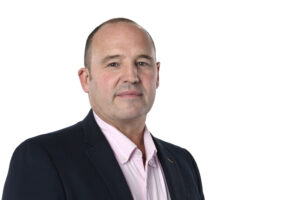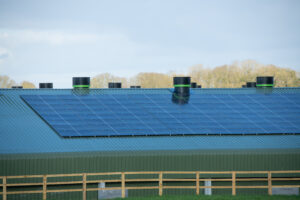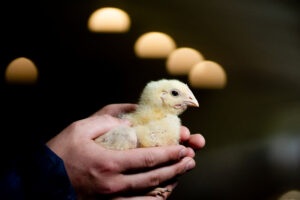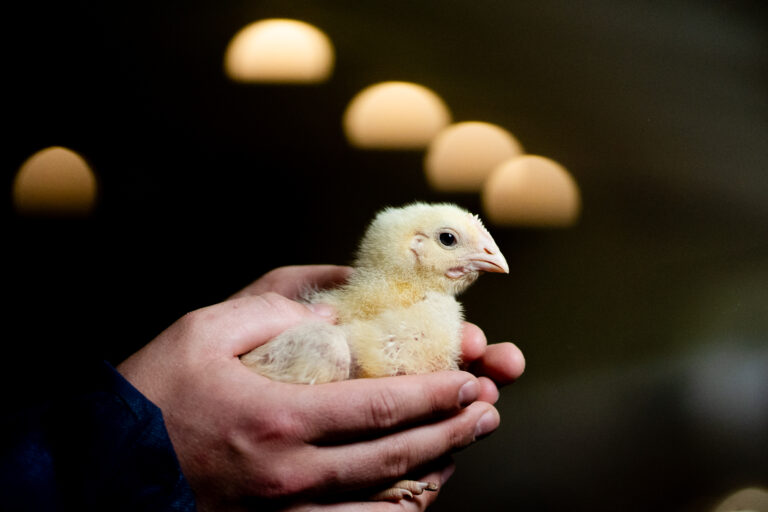Moy Park was named Processor of the Year at the 2024 National Egg & Poultry Awards. Michael Barker discusses the company’s achievements and future goals with Justin Coleman, poultry business unit director at Pilgrim’s Europe
Q: Could you give us a summary of the size of Pilgrim’s Europe’s chicken production operations currently?
JC: Pilgrim’s Europe, which brings together the Moy Park, Pilgrim’s UK and Pilgrim’s Food Masters businesses, operates more than 40 sites, including well-invested agriculture and food-production facilities across the UK, Ireland, France and the Netherlands. It is home to around 20,000 team members, working with thousands of farmers, suppliers, foodservice and retail partners.
Looking specifically at our poultry operations, we provide around 25% of the UK’s poultry production, processing over 200 million birds per year and around 200,000 tonnes of prepared food annually. Our integrated operation also includes several feed mills, enabling us to supply our farmers with high-quality feed ingredients resulting in improved animal health and performance.
Investing in our people and rural communities is at the very heart of our business and we work closely with 650 poultry farming partners.

Q: As we stand at the start of a new year, what are your hopes and expectations for the year ahead and what are the big challenges you foresee facing the sector?
Looking at the wider political and stakeholder context, 2024 was a year of change with a general election and new government as well as the return of a functioning Northern Ireland Executive earlier in the year. While there was a change in personnel, departments still face the same challenges. For our sector the biggest challenge we face is the need to continue to grow to feed the nation, in the most sustainable way.
Going into 2025 we would like to see a greater level of policy alignment on food, both between national and devolved governments and between departments. We need a comprehensive approach on food policy, with industry and government aligned on the key priorities of environmental protection, health, food security, planning and economic growth. Given this period of political stability, the resilience and knowledge of the sector, we are confident that through ongoing collaboration and partnership, we can continue to work together to deliver positively against these challenges and opportunities.
Q: How central to your success is having a fully integrated livestock system?
This is crucial to our past and future success, as we are able to collaborate across multifunctional teams to deliver value for our customer by taking a holistic approach. It enables a unique portfolio of welfare and operational benefits including a high standard of genetic quality serving as the foundation of high-quality stock. This system, together with our commitment to high husbandry standards and precision-farming technologies, is the bedrock of our success.
Q: What has been the focus of investment and innovation at Pilgrim’s Europe over the past year or so?
Since bringing together Moy Park, Pilgrim’s UK and Pilgrim’s Food Masters under the Pilgrim’s Europe structure, we have taken steps to drive operational excellence to become an even more customer-focused, efficient partner.
Across our poultry division, we continue to focus on investing in our infrastructure to maintain the highest standard across our facilities, animal husbandry, production and processing, the safety of our teams, and to exceed the ever-changing requirements of our customers.
We continue to invest in ways to better improve our birds’ lived experience and build on our industry-leading initiatives such as windowed housing, environmental enrichments, gut health research and our net-zero housing demonstrator at Beech Farm.

Q: What other ongoing trial or research work can you tell us about?
At Pilgrim’s Europe, we have a proud history of improving animal welfare through science and our collaborations with academia. Over the years we have worked with our academic partners to quantify improvements to our birds’ lives through introducing natural lighting, play bales, increased space and platform perches. All of these innovations have raised the bar for the whole industry and are included in industry and customer standards.
We continue to collaborate and invest in research that makes a tangible difference to our birds’ lived experience. We recently collaborated with academic partners to publish a peer-reviewed paper investigating the movement patterns of broilers to gain insights into their behaviour. By tracking individual chickens, we seek to explore how birds use the space and how they interact with their environment and each other.
We also continue to invest in our Doctoral Programme, whereby students are selected from both inside and outside of Pilgrim’s Europe to carry out research. Currently, we are supporting one of our team members to explore new management strategies for broiler chicks to improve health, welfare and performance. Currently their studies have investigated different hatching systems, including in-house hatching and providing access to feed and water for the broiler chick in the hatchery and assessing the impact on bird welfare. Looking forward, this study will be peer reviewed and published, providing the evidence to shape both our own and the wider industry’s thinking on the best hatching system to support welfare. All of our research aims to quantify and measure what the birds prefer and what is beneficial to their lives, not just what we think they would like.
Pilgrim’s Europe’s continued support for and engagement with forward-thinking farm animal welfare research demonstrates our commitment to relentlessly pursuing better ways to produce ethically reared chicken, pushing the industry forward.
Q: How do you see the move to lower stocking densities?
Ensuring adequate space is a core principle of our operations. We maintain a maximum planned stocking density of 38kg/m², which is well below the EU’s limit of 42kg/m². This essential standard is frequently audited by Red Tractor and our customers to guarantee strict adherence.
In 2023, we significantly increased the number of birds we grow under the higher-welfare umbrella, increasing by 40% to over half of our production. The shift underlines our drive to produce ‘higher-welfare’ chicken, and, in collaboration with our customers, brings an enhanced level of animal welfare to, most importantly our birds, as well as shoppers and consumers.

2024 was a momentous year for Pilgrim’s Europe as we stepped into rearing indoor slower-growing chickens to meet the Better Chicken Commitment standards, underlining our commitment to improving poultry welfare. Pilgrim’s Europe has become the largest producer of Better Chicken Commitment chicken in the UK, a move we are delighted and proud to play a role in.
Q: Where do you see the welfare drive going next?
Our approach to animal welfare is grounded in measurement and continually improving, relying upon strong governance.
As an organisation our goal is to provide chicken farmed with care for our retailers and consumers, ensuring that our practices of today are the foundations for a sustainable future. We are therefore committed to safe and sustainable farming practices.
Looking ahead, we are excited by the prospect of producing Better Chicken Commitment birds within our supply chain, in partnership with our key customers. While we have had significant experience with these birds through the breed-development phase, we are excited to experience them in a commercial setting and the improvement in welfare outcomes they will bring.
Our future remains focused on creating better, more sustainable food for all while upholding the highest standards of care for our birds. Together, we can set a new standard for excellence in animal welfare.
Q: How important is it to balance the interests of animal-welfare campaigners with the need to offer good-quality protein for all budgets?
We consider animal welfare as a condition, a fundamental element of our agriculture strategy. We prioritise the health and welfare of our chickens as a central pillar of our business, alongside people and food safety. This approach takes animal welfare beyond the five freedoms, giving our birds the best-possible conditions and care. We are resolute in our focus to deliver enhanced welfare outcomes, across all production systems.
Q: How are you dealing with the other big challenges facing poultry producers right now, such as avian flu, cost inflation and so on?
Demand for poultry as nutritious, healthy and great-value products is strong, which does leave us well positioned against headwinds. Our journey of continuous improvement and commitment to operational excellence helps us overcome sectoral or industry challenges.
In our experience, when facing big challenges, timely and relevant communication with experienced teams is paramount. We have several initiatives that ensure our preparedness in case of industry issues. Our ‘Welfare Hub’ and ‘AI Hub,’ keep colleagues informed about our latest animal-welfare developments, real-time AI alerts, the latest innovations, along with pertinent industry updates.
This year also saw us create the ‘AI Hub’, a comprehensive source of information on avian influenza. The AI Hub offers valuable resources for team members, including real-time company disease alert status and insights into biosecurity measures aimed at mitigating the risk of AI outbreaks.
Q: What are you doing in terms of sustainable soy usage and the search for alternative feeds?
The sustainable sourcing of soy is a critical issue for the global food industry – and one that we are committed to tackling proactively. Supporting market transformation, we want to play our part and see physical supply chains of sustainable, zero-deforestation and conversion-free soy into the UK and Europe. We keep in close contact with all soy suppliers to comply with upcoming regulation and our commitments.
As members of the UK Round Table for Responsible Soy, signatories of the Cerrado Manifesto Statement and active members of the UK Soy Manifesto, we publish our progress towards this goal and continue to collaborate with industry on solutions to ensure all deforestation risk commodities are verified deforestation and conversion-free by the end 2025.
Q: Can you summarise your other sustainability initiatives?
At Pilgrim’s Europe, we want to harness our scale and influence to help the food industry be a part of the climate solution, seeking even more sustainable ways to continue meeting our society’s nutritional needs. We recognise the challenges posed by climate change and are determined to address them boldly, with a strong emphasis on welfare. We have found time and time again in all challenges that we have faced that collaboration is key to our success. It is obvious to us that we are stronger together and we are deeply grateful to our team members, farming suppliers, industry bodies, and academic partners for joining us on this journey.
Q: Does the company have a stated net-zero goal, and if so how is progress going?
Our ambition is to reduce emissions in line with science to be net zero by 2040.
Some of our interim steps include:
- Scope 1 & 2 target to reduce absolute emissions by 43.8% by 2030 versus a 2021 baseline;
- Our plan is to move to 100% renewable electricity across our poultry facilities by the end of 2025;
- Reduce water use intensity by 15% by 2030 vs 2019 baseline;
- Ambition to achieve verified deforestation and conversion-free commodities by end of 2025.
Q: To what extent are you incorporating new technologies into your business?
Data gathered from technology and monitoring can play an incredible role in farm management and improvement, and we’ve had great success implementing well-thought-out innovations across our farm estate.
For example, our state-of-the-art Beech farm in Lincolnshire uses a range of technologies including ground source heat pumps to generate heating, heat exchanger systems to reduce overall heat usage, and solar technology capable of generating an impressive 1MW of electricity, which will work in tandem with lithium battery storage, to effectively taking the farm ‘off grid’.
Another great example of new technology in action is our Farm Carbon Calculator, a best-in-class tool that uses real data across all metrics to capture, benchmark and track changes in emissions. This real-time carbon footprinting is used to drive continuous improvements across our supply chain, such as new investments, farming practices and training.
Q: Is there any more support you’d like to see from government?
It is important for governments to understand that growth and sustainability are not in opposition to each other. Economic growth is key to delivering the investment we need across industry and society. Growth enables us to invest further in the innovation that will deliver sustainability while continuing to support good jobs and produce safe, quality, nutritious food.
Q: What did it mean to the business to be named Processor of the Year at the National Egg & Poultry Awards?
We hold ourselves to a high standard and our vision is to become the best and most respected company in our industry. Being named Processor of the Year is an honour and a strong indicator that we are doing a good job on our journey to achieving that vision.
Q: Overall, what would you say are the key factors that make Pilgrim’s Europe a standout business?
We believe that the success of our company starts with the success of our people, in our workplace and in the communities in which we operate. We are so grateful to our teams and communities for their ongoing support and commitment.
Our scale also puts us in a prime position to help lead the way through best-practice and purposeful, results driven initiatives. We want to help facilitate progress and actively engage with industry and business to share knowledge.


